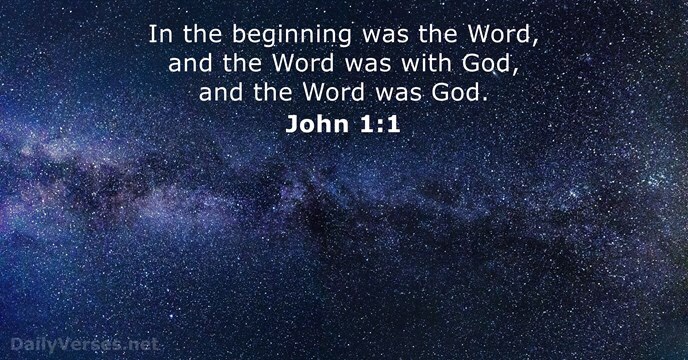The book of signs, which we know as the Gospel according to John, begins with a beautifully poetic Prologue (1:1–18). As well as being a piece of poetry, it is a piece of theology; it sets out many of the key themes of the whole work. The Prologue is the Gospel reading for this coming Sunday, the second Sunday in the season of Christmas. It offers a rich array of ideas for consideration. Only some of them are in focus in what follows.

1. The Prologue begins by introducing the main character of the story: the pre–existent Logos, the word made flesh, Jesus Christ, the one who “makes God known” (1:1, 14, 17-18). This motif of word runs consistently throughout the work: Jesus “speaks the words of God” (3:34; 8:47; 12:50; 14:8–10; 17:14), gives teaching which is “from God” (7:16–18; 14:24; 17:7–8), makes known “everything that I have heard from my Father” (15:15), utters words of “spirit and life” (6:63, 67). For the author of this Gospel, Jesus is, indeed, the Word who was always with God (1:1).

2. Already in the Prologue the narrator speaks of the rejection of the Word (1:10–11). This is played out in the body of the Gospel, especially in chapter 10, with references to the threat posed to the sheep by thieves and bandits (10:1, 8, 10), strangers (10:5), the hired hand (10:12–13), and wolves (10:12). The menace posed by these figures leads Jesus to infer that some of his sheep will be “snatched” out of his hand (10:28–29). At this, the Jews prepare to stone Jesus for the second time (10:31; the earlier instance was at 8:59). This enacts the revelation made by Jesus in an earlier discourse, that his fate is to be hated by the world (7:7).
A fuller and more explicit exposition of this theme of opposition is given in the second Farewell Discourse, under the rubric of “the world hates you” (15:18–25). Jesus here predicts that his fate will set the pattern for the fate of his followers; “if they persecuted me, they will persecute you also” (15:20).
3. The words and ideas found in the Prologue to the gospel (1:1–18) have led to the hypothesis that Hellenistic Judaism had been influential in the context in which the gospel was shaped. The role of the Logos is akin to the role of Wisdom within Hellenistic Jewish literature —both as the agent by which God created the world, and as the means by which God reveals knowledge and truth to the world.
That Judaism had long been engaged with the dominant hellenistic culture, has been well proven by contemporary scholarship. Influences from the Greek–speaking world, and its hellenised culture, are reflected in numerous Jewish writings. In this gospel, the account of the Greeks who wish to see Jesus (12:20–22) is a clear indication of the interaction between the community of the gospel, and the wider hellenised world.
The issue is also raised by the question of the Pharisees at 7:35; “does he [Jesus] intend to go to the Dispersion among the Greeks and teach the Greeks?” The kind of Judaism which has influenced the gospel is not of the dominant, Pharisaic–rabbinic kind. It has become open to the wider hellenised world; perhaps the community which first received this Gospel had already become somewhat diversified in its composition.
4. An important motif running throughout this Gospel is that Jesus is to be regarded as the fulfilment of scripture. This feature is common to all four canonical Gospels. This interpretive stance is hinted at as early as the Prologue, in the comparison between Jesus and Moses (1:17). It is stated explicitly in the claim put on the mouth of Philip, “we have found him of whom Moses and the prophets wrote” (1:45), and in the words attributed to Jesus, “You search the scriptures, because you think that in them you have eternal life; and it is they that bear witness to me” (5:39).

There are fifteen clear quotations from Hebrew Scriptures in this Gospel. There are eight explicit references to scripture in the early chapters (1:23; 2:17; 6:31; 6:45; 7:38; 7:42; 10:34; 12:13–15), while a fulfilment formula is used in later chapters, to introduce seven such scriptural quotations (12:38–40; 13:18; 15:25; 18:9; 19:24, 28, 36–37). There is also a passing note that Judas died after betraying Jesus “so that the scripture might be fulfilled” (17:12).
However, the total significance of the Hebrew Scriptures in this Gospel is much greater than these sixteen occurrences, as the Gospel contains numerous allusions to specific scripture passages, such as references to Jacob’s ladder (1:51) and the sacrificial lamb (1:29, 36), as well as more generalised allusions to scripture. These allusions are much freer in their form and indicate that, for the author of this Gospel, the Hebrew Scriptures had become an integral part of his mind and heart, for he treats them with a freedom born from intimate familiarity.
5. In like fashion, a series of Jewish titles is embedded in the narrative as confessions by key characters of the significance of Jesus. The Prologue has introduced a key Johannine title for Jesus: the Word (1:1, 14).
In the extended preface that follows (1:19–51), Jesus is addressed as “Rabbi” (1:38, 49), “Messiah” (1:41), “King of Israel” (1:49), and “Son of God” (1:49). These claims about Jesus are all made also within the Synoptic traditions. The Johannine Jesus himself refers, in the allusive synoptic fashion, to the “Son of Man” (thirteen times, from 1:51 to 13:31), which we must presume to be a self–reference. In later scenes, Jesus is also called “prophet” (4:19), “Messiah” (4:29; 11:27), and “Rabbouni” (my teacher, 20:16). These are all Jewish titles.
6. The ultimate Christological confession of the Gospel is uttered by Thomas, when he moves beyond this viewpoint in the phrase, “my Lord and my God” (20:28), echoing the perception of the Jews, that Jesus was “making himself equal to God” (5:18). Is this already alluded to in the conclusion of the Prologue, in the affirmation, “it is God the only Son, who is close to the Father’s heart, who has made him known” (1:18)?

For the most part of this Gospel, Jesus is presented in terms drawn from within a Jewish context. Indeed, even the confession by Thomas can be understood within a particular stream of Jewish tradition, for the hellenisticJewish author Philo uses the terms “Lord” and “God” to designate the two major divine powers of creation (signified by “God”) and eschatological judgement (signified by “Lord”).
7. Another characteristic which dominates the Christology of this Gospel is the Father-Son relationship (3:35–36; 5:19–23, 26; 6:37–40; 8:34–38; 10:32–38; 14:8–13; 17:1–5). This relationship is hinted at in the Prologue in 1:18, where the “only-begotten son” is portrayed as being “next to the breast of the Father” (my literal translation), or “close to the father’s heart” (NRSV). In one of his disputes with the Jewish authorities, Jesus declares that he does his works “so that you may know and understand that the Father is in me, and I am in the Father” (10:38).
This mutual interrelationship is brought to the pinnacle of its development in the lengthy prayer of chapter 17: “you, Father, are in me, and I am in you” (17:21). The purpose of describing this relationship in this way is to strengthen the claims made for Jesus, to validate him as authoritative, in the context of debates with the Jewish authorities.

8. Finally, Jesus is perceived as being “equal with God” (5:18). At the narrative level, this is a polemical view of Jesus, attributed to the Jews. However, the author of the Gospel clearly wants the readers to agree with the claim. This is supported by further comments such as: it is clear that he is the Messiah, for he is “doing the works of God” (10:24–25); he is “making himself a god” (10:33); “he has claimed to be the Son of God” (19:7); and he is acclaimed as “Lord and God” (20:28). It is also signalled in the closing verse of the Prologue: “it is God the only Son [or, the Father’s only son], who is close to the Father’s heart, who has made [God] known” (1:18).
This is the strongest claim made about Jesus; it lifts him above the realm of human debate and, as a consequence, it also lifts the claims made by his disciples, in his name, above that human realm. By this means, the community of his followers lay claim to a dominant, privileged position, vis–a–vis the Jewish authorities. The Christology which is proclaimed in the written Gospel has thus been developed and refined in the controversies and disputes of the community over the preceding decades.
9. Later Christian theology developed the doctrine of the Trinity, in which God, Jesus and the Spirit relate to one another as equals. Whilst the Gospel of John provides biblical warrant for the equality of Father and Son, the role of the Spirit is less prominent. Jesus is endowed with the Spirit at his baptism (1:32–33) and gives the Spirit to others through the words he speaks (3:34).
However, the Spirit is clearly subordinated to the Son in this Gospel. It is not until after Jesus is glorified that the Spirit is given (7:39; 20:22). The role of the Spirit is to be the Advocate of the Son (14:16, 26; 15:26; 16:7), sent by the Son to testify on his behalf (15:26) and to represent what has already been spoken by Jesus (14:26; 16:13–15). As the Son testifies to the truth (1:14, 17; 8:32, 45–46; 14:6; 18:37), so the Spirit is “the spirit of truth” (14:17; 15:26; 16:13).

So the book of signs provides pointers towards this central Christian doctrine, but does not actually articulate it in the categories and using the terms from later debates amongst the Church Fathers and decisions made by the various Councils of the Church. We need to hear the message of this Gospel in its own terms, in its own context, in its own right.
